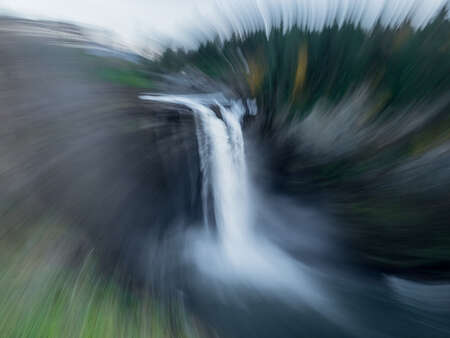When can a blurry photo be great? When you purposely create the blur with ICM – Intentional Camera Movement. ICM is deliberate movement of your camera, lens or both relative to a subject during a long exposure. With practice you can learn to intentionally blur a wide variety of subjects in an endless number of ways, creating unique impressionistic images.
As travel photographers, we enjoy creating ICM images for our clients. As Olympus Educators, we love helping others discover the joy in this playful style of photography. It’s different and powerful, unbound from the real-time images we see with our eyes and brains. We encourage you to give it a try!
Why ICM?
ICM is fun! It rewards experimentation, embraces the power of play and flexes our creative muscles. We especially love ICM because of its accessibility. You can use it to create one-of-a-kind artistic images indoors or out, with a wide variety of subjects, even with cluttered backgrounds and harsh midday light.
ICM 101: Mode, Shutter Speeds, Lenses and Filters
We work in shutter priority mode while creating ICM photos, with exposures of 1/8 to 1/2 second, or longer. After a few frames, we review images and adjust shutter speed as necessary to produce the effect we want.
To get slow shutter speeds in bright light, you’ll need a low ISO and high f-stop. You may also need to add a polarizing or neutral density filter. The Live ND feature on our OM-D E-M1X and E-M1 Mark III replicates the effect of putting a neutral density filter on a lens, making it quick and easy to get slow shutter speeds on sunny days.
We create ICM images with both zoom and prime lenses, and wide and tele focal lengths. Our M.Zuiko 12-40mm, 12-100mm and 12-200mm lenses are especially great for the zooming techniques discussed below. We use single vs. continuous autofocus and usually turn off image stabilization (exceptions discussed below).
ICM Techniques – Shake, Twist, Zoom and Pan
There is no right or wrong with ICM. We encourage you to dive in with a variety of subjects, and experiment with different types of camera motion and various shutter speeds. Here are a few techniques to try:
Shake
For abstract blur with any lens, gently shake or move your handheld camera while the shutter is open. A little movement goes a long way (especially with longer focal lengths), but you’ll want enough blur in your image so that it looks intentional.
Movement in a pattern, like a wave or a circle can be fun. Here the “wave” technique resulted in an abstract image of a flower bouquet, shot indoors at night.
Twist
For another effect, pretend there is a laser beam running from your sensor through the center of your lens to your subject. Smoothly rotate your camera in a partial circle, as if it were a steering wheel, keeping the laser pointed at one spot on your subject. We often center our subject and pre-focus. Try different shutter speeds and rotation speeds, and twist both clockwise and counterclockwise.
We love to create ICM images at the Chihuly Garden and Glass Museum in Seattle – here are a couple “twists” made there.
Straight Zoom
Zoom lenses offer additional creative possibilities with a “spin-art” effect. For a Straight Zoom, hold your camera body still while smoothly zooming the lens while your shutter is open. This creates dramatic radial movement and depth. Again, it can work well to center your subject and pre-focus. We generally zoom from wide angle to tele, but encourage you to try tele to zoom as well. When creating zoom ICMs where we want the center in focus, we turn on image stabilization or use a tripod.
Twist Zoom
For a fun “twist zoom” variation, hold your zoom lens barrel still with your left hand while smoothly rotating your camera with your right hand, zooming the lens while the shutter is open. You can do this on tripod if your lens has a tripod collar. With this technique, the focal length changes and the sensor rotates relative to the subject, creating an image with spiral movement.
Infinite Variation
ICM is fun and liberating because there are so many ways to vary each technique and the lines between them blur – pun intended!
With any of the techniques above and even longer shutter speeds (3 or 4 seconds), interesting images can result if you divide a single exposure into 2 parts, and only do ICM during part of the exposure. For the first part, hold your camera and lens still, and let your Olympus camera’s powerful image stabilization do its magic. During the second part of the same exposure, play with shake, twist and/or zoom. This results in a traditional still image overlain with whatever motion you add. Here are two we created at Crystal Mountain near our home in Seattle.
Pan
If you’re photographing action and want a sharp subject against a blurred background, try panning. We do this often for travel clients, and enjoy helping our workshop and photo tour participants master this “traditional” ICM technique.
First, switch to shutter priority mode and select an initial shutter speed. Generally, the slower your subject is moving and the shorter your lenses’ focal length, the slower your shutter speed needs to be. For cyclists start with 1/10 or 1/20, cars 1/20 - 1/45, and race cars with a long lens 1/250 - 1/500. Slow your shutter speed further if the background doesn’t blur to your satisfaction; speed it up if the subject isn’t as sharp as you’d like.
Holding your camera steady, smoothly rotate your upper body at the waist at the same speed as your subject, keeping your autofocus point on the subject. Just like swinging a baseball bat, it’s important to start your upper body rotation before pressing the shutter, and follow through at the end. Practice on bicyclists on a busy path or on cars – from a safe and unobstructed place – and you’ll soon get sharp subjects at lower and lower shutter speeds. While it’s great to gain the skill to pan a perfectly “frozen” subject against a blurred background, sometimes a little subject blur makes an image fantastic!
And as with all ICM, anything goes - try a vertical or diagonal pan.
ICM is playful and powerful. It’s all about the movement of your camera relative to your subject and background, and the feeling it evokes. Since there are infinite ways to move your camera, the creative possibilities are endless. So get out there and shake, twist, zoom and pan!
Instagram: @merrillimages
John and Lisa Merrill create images to evoke wonder, inspire action and strengthen communities. Based in Seattle, the Merrills are inspiring photo educators who help others nurture their creativity through Pacific Northwest workshops and international photo tours.
















